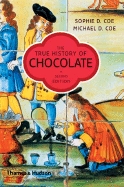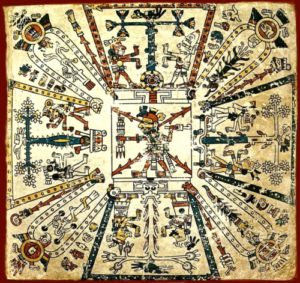The True History of Chocolate. / Sophie D. Coe and Michael D. Coe. Published by Thames and Hudson, 2007, c1996. 280 pages, illustrated; with Notes, Bibliography and Index.

A true history implies that things once hidden or obscured are now offered in plain sight. True but almost unbelievable is the social history of the chocolate bean. A little container of seeds, about the size of an almond is accountable for the range of human responses to this natural phenomenon, from awe to manipulation. In The True History of Chocolate, authors Sophie D. Coe and Michael D. Coe regale us with factual stories of the bean and its meanings in different cultures over a span of almost 4,000 years. Its edible fruit was first discovered, and then purposefully planted and harvested in the Americas for centuries, and now is grown within a 20 degree band above and below the equator, world wide.

Originally this tree grew in the foothills of the Andes Mountains but became naturalized, by extensive cultivation, in more northern regions, becoming a focal point in spiritual rituals of Olmec, Mayan and Aztec peoples. In one Codex (see illustration), say the authors, cacao symbolized the color red, human blood, the southerly direction, and the Land of the Dead. It provided one fourth of the earth’s bounty together with three other life-giving, or fruit-bearing trees. These beliefs were associated with a kind of power engendered by knowledge of both physical and spiritual life. Thus cacao, and by extension, chocolate, really was the food of the gods.
We say chocolate grows on trees, well it almost does. The dark, sweet confection, called cacao by some, begins in a bean-bearing pod that’s attached to the trunk of a tropical tree known as Theobroma cacao, which is native to South America. Inside the pod, a thick, sweet pulp surrounds an organization of beans and keeps them nourished until harvest. The pulp makes an excellent and sweet drink, but it isn’t chocolate. People tended the trees at first, about 3800 years ago, for this delicious liquid and may not then have used the beans or seeds. A little later, plantations of cacao were cultivated, most likely for the beans and seeds as well, as early as 3300 years ago, and then the people began to exploit its combination with herbs and spices to create heavenly drinks. They mixed it with maize, nuts and ear flowers, and sometimes the seeds of an herb that produces a deep red color.
Pods from the chocolate tree contain beans which inside hold many seeds, and these go through a maturation process and then are released, or winnowed, from their shells and ground into a paste; later, it’s mixed with sugar and spices or flavorings to make chocolate. This is a very brief description of chocolate. Its culinary development involves more ingredients, but in short, cacao seeds, straight from the pod, must be coaxed into achieving the expected chocolate taste. This has to be done by human intervention—it doesn’t happen on the tree. First, after harvest, workers keep the beans in the pod and this surrounds them with life-giving water—the pulp. With heat, the pulp dissolves, providing an acid bath to help the seed germinate, and then is suddenly halted as if turned off by a chemical clock. At that point, the bitter taste within the seed is greatly decreased, and the taste of chocolate can be developed.
But considering that the first chocolate lovers took their pleasure in chocolate drinks and porridges with no sugar added, a process described as post-harvest cultivation was all they required. A bar of chocolate hadn’t been invented yet. And yet their chocolate was as valuable, maybe more valuable, to hearth and heart than is ours because they depended on it for sustenance: grew it, traded it, drank it, and offered it to their gods.
Follow


